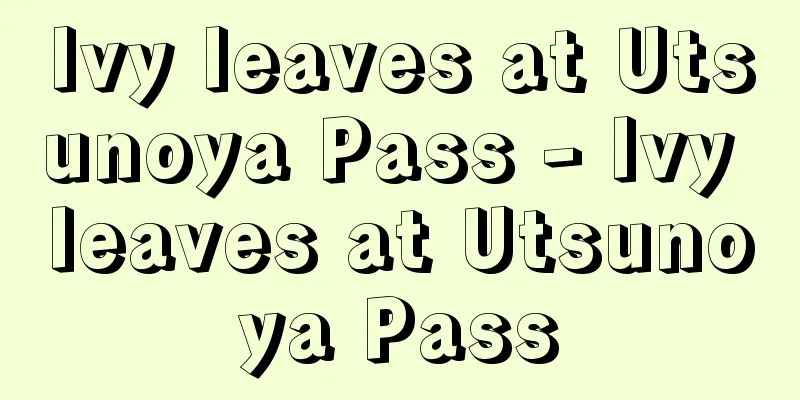Ivy leaves at Utsunoya Pass - Ivy leaves at Utsunoya Pass

|
A Kabuki play. A domestic drama. Five acts. Written by Kawatake Mokuami. It was first performed in September 1856 (Ansei 3) at the Ichimuraza in Edo by Ichikawa Kodanji IV as the head of the troupe, Zato Bunya, and Daiba Nisa, and Bando Kamezo I as Itamiya Jubei. It is based on a human interest story by Kingentei Basho, and is commonly known as "Utsuya Pass" or "The Murder of Fumiya." On his way to Kyoto to obtain a government position with the 100 ryo his sister Okiku made by selling herself to Yoshiwara, the troupe leader Fumiya is targeted by Goma-haedeva Ninzou at Mariko's inn, but is saved by Itaya Jubei, who is also staying at the inn. Struggling to raise the 100 ryo to save his master Saizaburo, Jubei leaves the inn with Fumiya behind, and is forced to kill Fumiya at Utsuya Pass and steal the money. Afterwards, Jubei is tormented by Fumiya's vengeful spirit and is blackmailed by Ninzou, who witnessed the murder. He finally kills Ninzou at Suzugamori and is captured himself. This was the first film that established the pairing of the great actor Kodanji and the great writer Mokuami. The script also includes two love stories between Okiku, later the prostitute Kokin, and Hikozo Shirakiya, and between Hikozo's younger sister Koma and Saisaburo, but the highlights are the murder of Fumiya at Utsuya Pass and the blackmail scene at Itaya. Since the premiere, the rule has been to play the two contrasting roles of Fumiya and Jinzo in quick succession, and in modern times, the combination of Onoe Kikugoro VI playing the two roles and Nakamura Kichiemon I playing Jubei has been outstanding. In 1969 (Showa 44), the National Theater performed the entire play for the first time since the premiere, with Nakamura Kanzaburo 17th and Matsumoto Koshiro 8th (Hakuō) receiving favorable reviews. [Toshiaki Matsui] Source: Shogakukan Encyclopedia Nipponica About Encyclopedia Nipponica Information | Legend |
|
歌舞伎(かぶき)脚本。世話物。五幕。河竹黙阿弥(もくあみ)作。1856年(安政3)9月江戸・市村座で、4世市川小団次(こだんじ)の座頭文弥(ざとうぶんや)と提婆(だいば)の仁三(にさ)、初世坂東亀蔵(かめぞう)の伊丹屋十兵衛(いたみやじゅうべえ)により初演。金原亭馬生(きんげんていばしょう)の人情噺(ばなし)に取材したもので、通称「宇都谷峠」「文弥殺し」。座頭文弥は、姉お菊が吉原へ身売りしてつくった百両の金で官位をとろうと京へ上る途中、鞠子(まりこ)の宿(しゅく)で胡麻(ごま)の蠅(はえ)提婆の仁三にねらわれるが、同宿の伊丹屋十兵衛に助けられる。主人才三郎を救う百両の調達に苦しむ十兵衛は、文弥を送って宿をたち、宇都谷峠でやむなく文弥を殺して金を奪う。その後、十兵衛は文弥の怨霊(おんりょう)に苦しめられ、また殺しの現場を目撃した仁三から強請(ゆす)られ、ついに鈴ヶ森で仁三を殺し、自分も捕らえられる。名優小団次と名作者黙阿弥のコンビが確立された第一作。脚本はほかにお菊のちに遊女古琴(こきん)と白木屋彦三(ひこぞう)、彦三の妹お駒(こま)と才三郎という二組の情話が添えてあるが、見どころは宇都谷峠の文弥殺しと伊丹屋の強請り場。初演以来、文弥と仁三という対照的な二役を早替りで演ずるのが原則で、近代では6世尾上(おのえ)菊五郎の二役と初世中村吉右衛門(きちえもん)の十兵衛のコンビが傑出していた。1969年(昭和44)国立劇場で17世中村勘三郎、8世松本幸四郎(白鸚(はくおう))により初演以来の通し上演が好評を得た。 [松井俊諭] 出典 小学館 日本大百科全書(ニッポニカ)日本大百科全書(ニッポニカ)について 情報 | 凡例 |
Recommend
Kaisariya - Kaisariya
…The second was used as an office for wholesale m...
Indirect exchange arbitrage
…This is also the result of arbitrage. When arbit...
"The Life of Don Pablos, the Storyteller" - The Life of Don Pablos, the Storyteller
...His works, born from criticism of the ugly asp...
GUM
A brand name of dental care products sold by Sunst...
Abel, KF - Abel
…In 1764, he taught the eight-year-old Mozart whe...
Canut, Y.
He gained popularity playing the role of a "...
Japanese mathematics - Wasan
Mathematics that developed uniquely in Japan duri...
Uchinoichi - Uchinoichi
…In contrast, Eika City and Atokuwa City were loc...
Ammannati, B.
...The latter two continued to be active after th...
Fainting - fainting
Although it is not an academic term, it generally...
Kyushu Minkento Party
…In 1919, he organized steelworkers in Yawata int...
Barbascome
It is a genus of the Scrophulariaceae family found...
Hard storehouse
…JR Joban Line and National Route 6 run through t...
Olsen, H.
...Large synthesizers have many of these basic fu...
China-Vietnam border issue
A dispute over the border between China and Vietna...

![Minamioguni [town] - Minamioguni](/upload/images/67ccf3e2772c9.webp)







